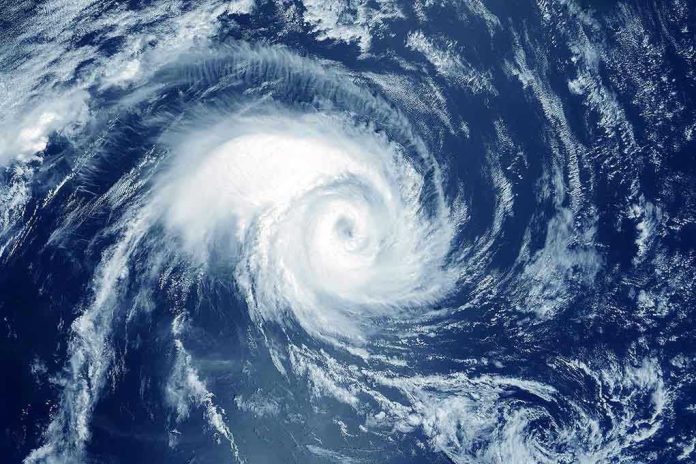
When a hurricane stalls over the Caribbean, the difference between survival and catastrophe is measured not just in miles per hour, but in hours spent beneath unyielding wind and water.
Story Snapshot
- Tropical Storm Melissa is forecast to escalate into a major hurricane within days, threatening catastrophic impacts for Jamaica, Haiti, Cuba, and the Dominican Republic.
- The storm’s unusually slow movement could unleash prolonged, devastating winds and life-threatening flooding.
- Forecast uncertainty and the region’s vulnerability heighten both risk and anxiety for millions in its path.
- Authorities urge urgent completion of storm preparations as models suggest potential for rapid intensification.
Melissa’s Threat: Not Just Strength, But Relentless Duration
Forecasters tracking Melissa see more than just another late-season hurricane threat. The storm’s defining danger lies in its pace—a sluggish, unpredictable crawl through the central Caribbean. At just 1 mph, Melissa’s westward drift means communities won’t face a single night of fury, but potentially days of battering winds and relentless rain. This slow-motion disaster scenario transforms what might be a routine hurricane alert into a high-stakes waiting game for millions, especially as the storm’s structure teeters on the edge of rapid intensification.
Emergency officials in Jamaica, Haiti, Cuba, and the Dominican Republic have issued stark warnings: Melissa’s crawl could multiply risk, delivering not only the expected hurricane-force winds but also record-breaking rainfall totals. In mountainous Haiti, where deforestation has left hillsides prone to collapse, even moderate storms can unleash deadly landslides. With the specter of past disasters—like Hurricanes Matthew and Dorian—still fresh, the region braces for a potential reprise, now complicated by Melissa’s unpredictability.
A Recipe for Rapid Intensification—and Uncertainty
Melissa’s journey began as a mid-October disturbance, a familiar player in the Caribbean’s hurricane season drama. Yet, despite early setbacks from wind shear that disorganized its structure, forecasters now see signs of imminent change. Oceanic heat content in the storm’s path ranks among the season’s highest, and wind shear is projected to decrease. If Melissa’s circulation aligns vertically—an event meteorologists warn could occur within the next 72 hours—the ingredients for rapid intensification will be in place. The stakes: a possible leap to major hurricane status by early next week, with little time for final preparations.
Forecast models, while consistent in predicting strengthening, diverge on the storm’s future track. Some suggest a direct hit on Jamaica; others show a shift toward Cuba or the Dominican Republic. This uncertainty forces authorities to expand warnings and keep millions on alert. Air Force Reserve and NOAA Hurricane Hunter missions are underway to collect vital data, but the clock ticks relentlessly.
Vulnerable Communities on Edge: Human and Economic Toll Looms
For Caribbean nations already familiar with hurricane heartbreak, Melissa’s threat is both physical and psychological. Infrastructure across the region ranges from robust to precarious; in Haiti, many homes remain vulnerable to even minor flooding. Prolonged exposure to hurricane conditions could trigger widespread power outages, impassable roads, and food and water shortages. The slow movement also threatens agriculture and tourism—the economic lifeblood of many islands—potentially inflicting losses that ripple far beyond the storm’s immediate path.
Social cohesion and political stability will be tested as governments balance the urgency of evacuation orders with limited resources and lingering distrust from past disaster responses. International relief agencies, already mobilizing in anticipation, warn that the humanitarian needs could be severe—especially if landslides cut off remote communities or if urban flooding forces mass displacement. Insurance markets and aid organizations alike are bracing for claims and calls for assistance, knowing that each hour Melissa lingers increases the tally of damage and need.
Expert Consensus: Slow Storms Are the Most Dangerous
Meteorologists and disaster management experts agree: slow-moving hurricanes are often the deadliest. While wind speeds and pressure readings dominate headlines, it’s the duration of exposure that sets disasters like Katrina and Harvey apart from lesser-known storms. In the Caribbean, the combination of steep terrain, vulnerable infrastructure, and densely populated lowlands makes the threat even more acute. Academic studies on past hurricanes repeatedly highlight how rainfall-induced flooding and landslides cause more fatalities than wind, especially when storms linger.
Climate scientists also raise concerns that warming oceans may be making slow, intense storms more common. For now, the consensus from the National Hurricane Center and regional meteorological agencies is clear: Melissa’s path and pace demand urgent attention. The warnings are not hypothetical; they are grounded in both hard data and hard-won lessons from a region that has seen too many storms overstaying their welcome.
Sources:
Zoom Earth: Live tracking, forecasts, and expert analysis of Tropical Storm Melissa
Weather Underground: Real-time storm data, maps, and forecast models












